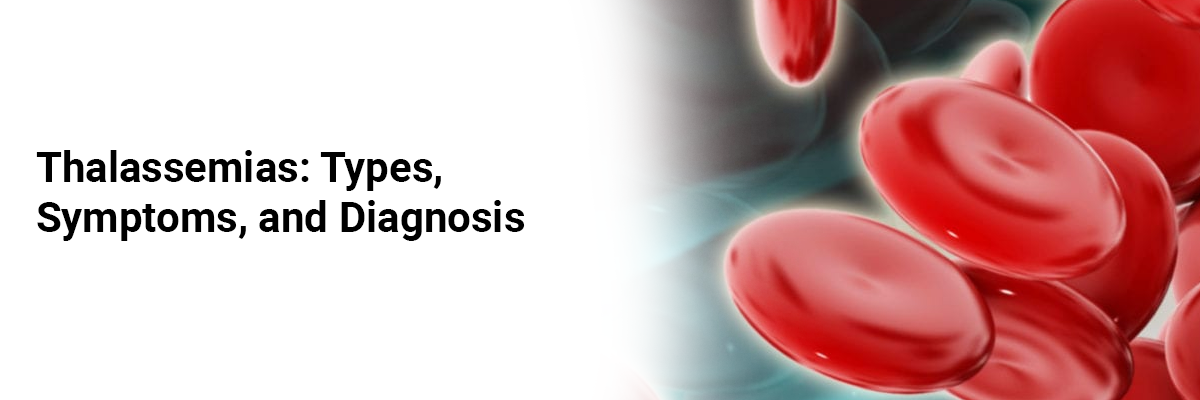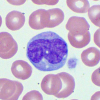
 Mrs. Mayuri Mathur
Mrs. Mayuri Mathur
Thalassemias: Types, Symptoms, and Diagnosis
Thalassemias are a group of genetic blood disorders characterized by abnormal production of hemoglobin, the protein responsible for carrying oxygen in red blood cells. These genetic and inheritable conditions are widespread globally, particularly in regions with high malaria prevalence. Individuals with Mediterranean, South Asian, or African ancestry are at a higher risk of inheriting this condition from one of their parents.
Hemoglobin consists of four protein chains: two alpha and two beta globin chains. Each chain is encoded by genes inherited from parents. These genes act as "codes" that regulate the production of each chain and, consequently, the formation of hemoglobin. Thalassemia can develop if any of these genes are faulty or missing. Hence, the parents become the thalassemia carriers, and each represents a 25% chance of passing on these faulty genes to their offspring.
Types of Thalassemias
Thalassemias are classified into different types based on the specific genes involved and the severity of symptoms. These labels describe a spectrum in which having a thalassemia trait means having moderate anemia symptoms or none at all.
• Alpha globin protein chains consist of four genes, two from each parent.
• Beta globin protein chains consist of two genes, one from each parent.
The type of thalassemia depends on whether the genetic defect is present in the alpha or beta chain. Hence, thalassemia can be broadly categorized into two types: alpha thalassemia and beta thalassemia.
Meanwhile, the severity of thalassemia in alpha-thalassemia is determined by the number of gene mutations inherited from the parents, as they are the genetic thalassemia carrier. The higher number of mutated genes one inherits from their parent, who are the thalassemia carriers, the worse their thalassemia will be. On the other hand, the severity of beta-thalassemia is determined by which section of the hemoglobin molecule is damaged.
Alpha thalassemia is caused by mutations in the genes that produce alpha globin, a component of hemoglobin. Since four genes produce alpha-globin, they can be further categorized into sub-types based on the number of gene mutations.
Different types of alpha-thalassemia are:
1. Silent Carrier: One gene mutation; individuals are asymptomatic carriers.
2. Alpha Thalassemia Trait: Two gene mutations; mild anemia may occur.
3. Hemoglobin H Disease: Three gene mutations; moderate to severe anemia and other symptoms.
4. Hemoglobin Bart's Hydrops Fetalis: Four gene mutations; severe anemia and life-threatening complications in newborns.
On the other hand, beta thalassemia is caused by mutations in the two genes that produce beta globin.
Different types of beta-thalassemia are:
1. Beta Thalassemia Minor: One gene mutation; mild anemia.
2. Beta Thalassemia Intermedia: Two gene mutations; moderate to severe anemia.
3. Beta Thalassemia Major (Cooley's Anemia): Two gene mutations; severe anemia requiring regular blood transfusions and lifelong treatment.
Symptoms of Thalassemias
Thalassemias can range in severity from mild to life-threatening. The symptoms vary in severity depending on the type and number of gene mutations. Common signs and symptoms of thalassemia include:
• Fatigue and Weakness: Reduced oxygen-carrying capacity of red blood cells leads to tiredness and lack of energy.
• Anemia: Thalassemias cause varying degrees of anemia, resulting in pale skin, shortness of breath, and rapid heartbeat.
• Growth and Developmental Delays: Severe forms of thalassemias can affect a child's growth and development.
• Bone Deformities: Excessive red blood cell production in the bone marrow can lead to bone abnormalities and skeletal deformities.
• Enlarged Spleen: Overactive red blood cell destruction in the spleen causes its enlargement, resulting in abdominal pain and a feeling of fullness.
Furthermore, iron accumulation from blood transfusions can lead to organ damage, particularly in the spleen, heart, and liver. If left untreated, these complications associated with thalassemia can progress to organ failure.
It is worth noting that individuals with hemoglobin H, a specific form of alpha thalassemia, have a higher risk of developing gallstones and an enlarged spleen. Regular monitoring and appropriate medical interventions are crucial to effectively manage and address these complications.
Diagnosis of Thalassemias
Most children with moderate to severe thalassemia are diagnosed before age two. People with no symptoms may not realize they are carriers until their child develops thalassemia. However, blood testing can determine if a person is a carrier or suffer from the illness.
Hence, a timely diagnosis of thalassemias is essential for effective management and treatment. The following diagnostic tests are commonly used:
• Complete Blood Count (CBC): Measures the levels of hemoglobin, red blood cells, and other blood components, helping identify anemia.
• Hemoglobin Electrophoresis: Separates different types of hemoglobin to detect abnormal variants, aiding in identifying specific thalassemia types.
• Genetic Testing: Analyzes the DNA to identify specific gene mutations associated with thalassemias, providing definitive diagnosis and carrier status information.
• Prenatal Testing: It involves obtaining samples of fetal cells to determine the presence of thalassemia genes during pregnancy.
The End Note
Thalassemias are a group of inherited blood disorders that can significantly impact your health and quality of life. In most cases, thalassemia cannot be avoided. But, if you suffer from thalassemia, recognizing the type of thalassemia, understanding its symptoms, and employing accurate diagnostic methods are crucial steps toward effective management and treatment.

Mrs. Mayuri Mathur
Mrs. Mayuri Mathur is a Senior Medical Writer (Patient education and digital) and seasoned content creator with a rich tapestry of expertise spanning over ten years. With a diverse background in content creation, she brings a wealth of experience to the table, from crafting insightful medical articles to developing comprehensive patient education materials, dynamic press releases, and captivating brochures and website content. Throughout her illustrious career, she has demonstrated an exceptional knack for distilling complex medical concepts into easily understandable content, making her a trusted resource for both professionals and lay audiences alike. Her meticulous attention to detail and innate creativity have enabled her to deliver content that not only informs but also engages and inspires. Whether elucidating intricate medical procedures or crafting compelling marketing materials, her versatility and dedication shine through in every project she undertakes. Her passion for writing, coupled with her profound understanding, makes her an invaluable asset to any team or project. In a constantly evolving digital landscape, where effective communication is paramount, Mrs. Mayuri Mathur stands out as a beacon of excellence, consistently delivering top-notch content that resonates with audiences across diverse platforms.

.png)

.png)
.png)

.jpg)










Please login to comment on this article